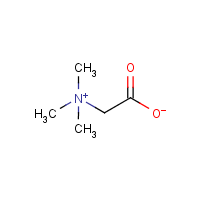Betaine
Agent Name
Betaine
CAS Number
107-43-7
Formula
C5-H11-N-O2
Major Category
Nitrogen Compounds

Synonyms
1-Carboxy-N,N,N-trimethylmethanaminium hydroxide, inner salt; Methanaminium, 1-carboxy-N,N,N-trimethyl-, hydroxide, inner salt; (Carboxymethyl)trimethylammonium hydroxide, inner salt; 2-(Trimethylammonio)ethanoic acid, hydroxide, inner salt; Abromine; Betaine; Glycine betaine; Glycine, trimethylbetaine; Glycocoll betaine; Glycylbetaine; Glykokollbetain [German]; Jortaine; Loramine AMB 13; Lycine; Oxyneurine; Rubrine C; Trimethylaminoacetic acid; Trimethylglycine; Trimethylglycocoll; alpha-Earleine; [ChemIDplus] Cystadane (anhydrous betaine for oral solution); [HSDB]
Category
Quaternary Amines
Description
Deliquescent solid; [Merck Index] Powder; [Alfa Aesar MSDS]
Sources/Uses
Occurs naturally in plants and animals; Used in the treatment of homocystinuria; [Merck Index] Used in soldering and resin curing fluxes, in organic synthesis, and in fisheries (promotes fish survival and aids transfer of salmon and trout from freshwater to seawater); [HSDB] "Trimethylglycine (TMG) is an organic compound that occurs in plants. Trimethylglycine was the first betaine discovered; originally it was simply called betaine because, in the 19th century, it was discovered in sugar beets. Since then, many other betaines have been discovered, and the more specific name glycine betaine distinguishes this one." [Wikipedia]
Comments
No evidence of mutagenicity; [HSDB] Does not cross the placenta well in animal experiments; [REPROTOX] Not irritating to skin or eyes of rabbits; Not sensitizing in guinea pig maximization test; No evidence of mutagenicity; [IUCLID] May cause irritation; [Alfa Aesar MSDS]
Biomedical References
Exposure Assessment
Vapor Pressure
5.34E-07 mm Hg
Diseases, Processes, and Activities Linked to This Agent
Processes
Industrial Processes with risk of exposure: